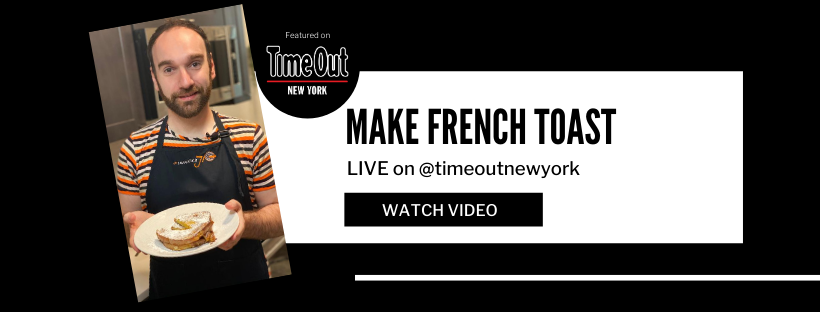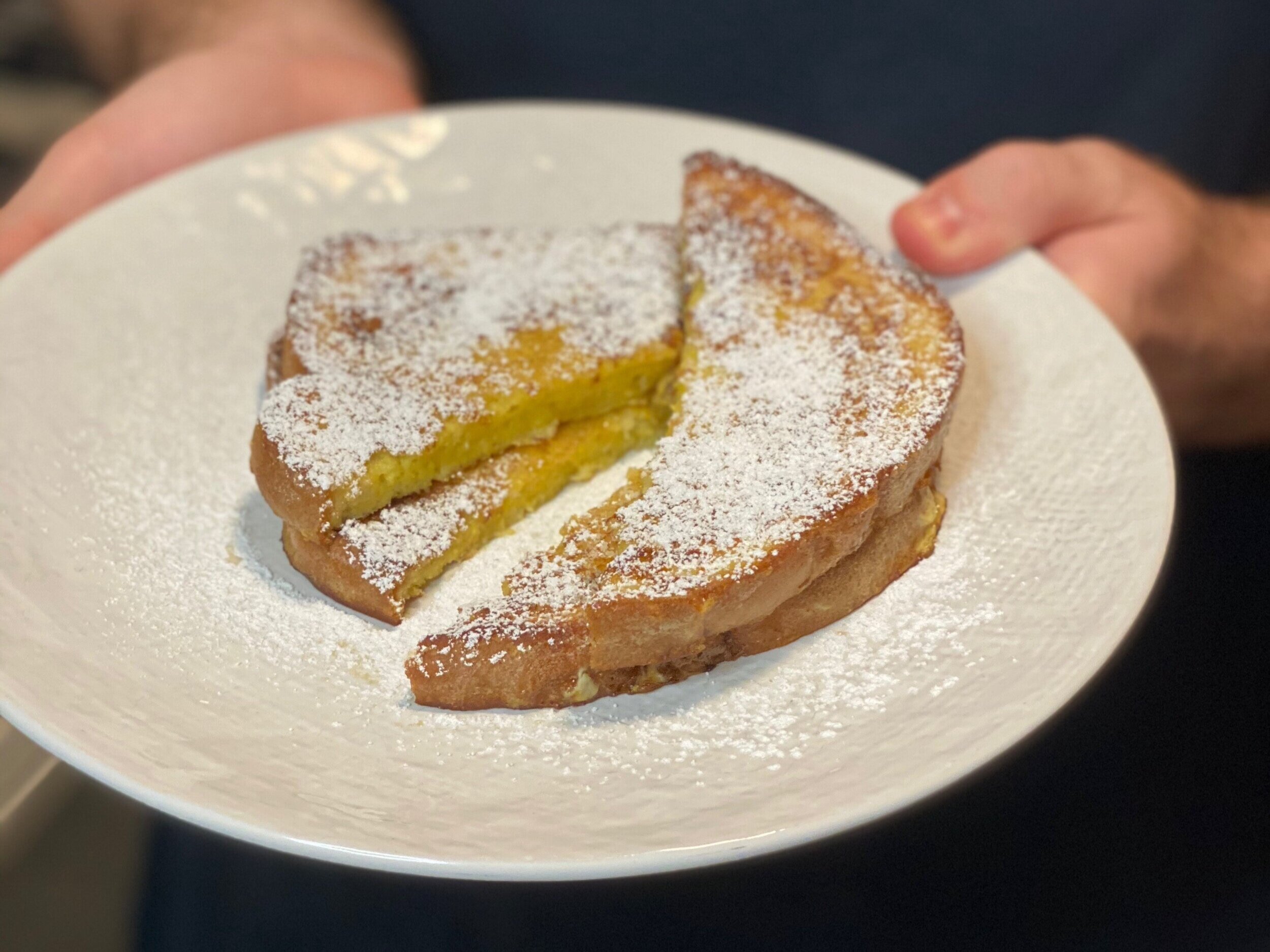
The Best and Most Authentic French Toast Recipe - Le Pain Perdu
Learn how to make great Pain Perdu, or French Toast with JP Linguistics. A recipe from a French chef with a South of France touch…
Pain Perdu is a great breakfast or brunch dish that is easy to make, doesn’t ask for much, and taste so good! This French dish, associated with a luxurious and decadent breakfast in America, has not always been so historically. Let’s dive into the history of the French Toast, and look at how to make an authentic Pain Perdu
French Toast or Pain Perdu?
To answer this question, we need to understand the origin of the dish. People have invented le pain (bread) to live a saucy life! Well, in any way, bread is life, we know it. The symbolism attached to bread is deeply anchored in religion making the disposal of bread in the trash, sacrilegious.
To this day, French people have specific ways of treating bread. There's a way to cut bread, with a special knife (couteau à pain), bread cannot be turned on it’s back, and bread should never been thrown in the trash. Bread can be reused to make breadcrumbs (de la chapelure) to be used in other recipes.
But we are degressing. The creation of the wonderful dish is said to come from this one baker, who was not able to sell his bread and the bread became stale. Since he did not want to throw it away and waste a potential income. Instead, the baker developed a recipe based on eggs and milk and turn the stale bread into a delicious treat, giving it’s name or Pain Perdu (lost bread). So, yes, it is a French invention, but it is not a typical toast. There is a reason behind it. So the real name should be Pain Perdu, but let’s be honest, marketing this name would be a little harder…
An Authentic Recipe of Pain Perdu
Inspirée d’une recette par Jean-Pierre Coffe
So let’s see what the hype is all about with this recipe and let’s learn a neat secret ingrédient to make the recette more French.
Ingrédients
25 cl de lait (1 cup of milk);
1 cuillère à soupe d’extrait de fleur d’orangers (1 tablespoon of orange flower water);
50 g de sucre de canne roux deux cuillères à soupe (2 tablespoons of brown sugar) ;
un sachet de sucre vanillé (vanilla sugar or vanilla extract) ;
six tranches de pain blanc (6 slices of white bread);
trois gros œufs entiers (3 large eggs);
25 g de beurre (1/3 cup of butter);
1 pincée de sel fin (1 pinch of salt) ;
confiture ou gelée au choix (marmelade or jam).
Recette (Recipe)
Dans un saladier, ajoutez le lait, le sucre de canne, le sucre vanillé, et l’eau de fleur d’oranger. (Start by adding the milk, the orange flower water, and sugars in a bowl)
Placez les tranches de pain dans un plat creux, mouillez avec le lait sucré, retournez-les pour qu’elles absorbent l’excédent de lait. Laissez reposer pendant quinze minutes. (lay the slices of bread in a hollow dish and pour the sweet milk on the bread, turning them to absorb the excess of milk)
Dans une assiette creuse, battez les œufs en omelette avec la pincée de sel et deux cuillères à soupe de sucre. (in a hollow plate, beat the eggs with a pinch of salt and 2 tablespoons of sugar)
Faites chauffer un peu de beurre dans une poêle sur feu doux. Trempez six tranches de pain dans les œufs battus, déposez-les dans le beurre chaud ; laissez dorer, retournez et faites dorer l’autre face. (Heat a little bit of butter in a pan). Dip each slice of bread in the beaten eggs and place them in the hot butter. Let them get golden and turn them over.)
Servez aussitôt avec les pots de confiture posés sur la table. (serve as soon as possible with your favorite Jam or marmelade)
Option: vous pouvez les saupoudrer de sucres glace. (You can also add confectionner sugar on top of a classy effect).
Bon Appetit!
Let us know how your Pain Perdu turned out! Leave a comment and send us your pictures! Dont forget to tune in on July 14th at 9am for our French Toast demonstration. You can fine the complete line up of events with Time Out New York in this article.
How to Make Croque Madame and Croque Monsieur?
Learn how to make and authentic French Croque Monsieur while learning some French vocabulary!
This cheesy and simple sandwich is the perfect Sunday dinner. It goes perfectly with a side of salad and pourquoi pas some home fries. This is a classic bistro food and the easiest way for parents to make dinner or lunch for the kids. In this recipe we are going the classy way and learning how to make a traditional Croque Monsieur with the famous Sauce béchamel!
Where Does Croque Monsieur Come From?
Well, it does come from France and is a typical dish in French Bistros, because it is fast to make. By the way, did you know that the word Bistro comes from the Russian word býstro, meaning “quickly”? When France was occupied by Russia in 1814, Russian soldiers use to come to French restaurants and asked for the food to be made quickly, hence the creation of bistros. So Croque Monsieur made their apparition around 1910 in several bistros and were mentioned by Marcel Proust himself in his book À l'ombre des jeunes filles en fleurs.
This simple sandwich evolved from a simple cheese sandwich to a more exquisite recipe when béchamel sauce was added. It also developed a feminine counterpart with the Croque Madame, which adds an egg à cheval (on top). Some families (AKA mine) used to prefer to put a slice of tomato on top instead of an egg, to make it “healthier”.
Recipe of Croque Monsieur with Béchamel Sauce
Ingrédients (ingredients)
Pour la béchamel (for the béchamel sauce)
25 g de beurre (1.5 Tbsp of butter)
25 g de farine (1.5 Tbsp of flour)
50 cl de lait (2 cups of milk)
sel, poivre, muscade (salt, pepper, nutmeg)
Pour le Croque Monsieur
8 tranches de pain de mie complet (8 slices of whole wheat bread)
125 g de Comté fraîchement râpé ou Cantal ou gruyère (1/2 cup of Swiss Cheese)
30 g de beurre (2 Tbsp of butter)
200 g de jambon blanc (8 -10 slices of ham)
Noix de muscade (nutmeg)
Sel (salt)
Commencez par la sauce béchamel. Dans une casserole, faites chauffer le beurre et une fois fondu, ajoutez la farine. Mélangez jusqu’à l’obtention d’un roux. Ajoutez le lait tout en remuant et continuer de mélanger pour que le mélange épaississe. Ajoutez du sel, du poivre et de la muscade salon votre got. Start with the Béchamel Sauce. In a sauce pan, heat the butter and use a whisk to make it melt. Keep on high heat. Once the butter is melted, quickly add the flour and whisk until all is turning into a roux. Then add the milk while whisking and keep mixing until it thickens. Then as salt, pepper and the nutmeg to taste. Set aside.
Placez 4 tranches de pain de mie et beurre-les. Ajoutez une fine couche de sauce béchamel et placez le jambon et le fromage rapé. Placez une autre tranche de pain pour fermer le croque monsieur. Lay 4 slices of bread and butter them. Add a thin layer of béchamel sauce, then add the ham and put the cheese on top. Put another slice of bread on top.
Ajoutez de la sauce béchamel sur le dessus du sandwich et ajoutez-y du fromage râpé. Faites cuire 10 minutes à 180 degrés Celsius. Add béchamel on top and grated cheese and put in the over for 10 minutes at 350 degrees Fahrenheit.
Envie d’un Croque Madame? Ajoytez un oeuf (au plat) sur le dessus et voilà ! Want to make it a Croque Madame? Add an over-easy egg on top and voilà!
Bon Appetit!
Let us know how much you love Croque Monsieur in the comments below and don’t hesitate to ask questions or add fun facts, and share with a friend!
Celebrate Bastille Day 2020 While at Home
Join JP Linguistics and Time Out New York to celebrate Bastille Day 2020 along with amazing and authentic French Brands in New York City!
Bastille Day - A Symbol of Freedom and Liberty
Have you ever wondered what the big deal with Bastille Day and the French was? Well, you are in luck because on Tuesday, July 14th we will explain all virtually during a full-day celebration we have planned. Although this year marks the first time that Americans are banned from travelling to Europe because of the Covid-19 pandemic, we partnered with Time Out New York to bring you authentic French experiences in NYC that you can enjoy by tuning in to their Instagram account, @timeoutnewyork, starting at 9:00AM on July 14th. Our event is also including in United for Bastille Day, organized by the Consulate General of France. Keep scrolling for a brief history of Bastille Day and more details about the event.
Gravure de la Bastille, par Jean-François Rigaud, XVIIe s.© DEA PICTURE LIBRARY https://www.geo.fr/histoire/la-bastille-400-ans-d-histoire-161952
What is Bastille Day?
Bastille Day or Le 14 juillet is the national day of France. It is on July 14th 1789 that the Bastille was destroyed and marked the beginning of the Fall of the Monarchy and of the French Revolution. The Bastille was build in the 14th century to protect the city and it became a symbol of Tyranny that people wanted to take down, as it had become a prison for people who opposed the political system in place. Most of the people who were emprisonned in the Bastille did not even received a proper judgement, instead, they received a lettre de cachet from the King who would condemned them right away. The Bastille was therefor a symbole of Tyrannie and not one of Freedom. This is why French people do not refer to this day as Bastille Day but as Le 14 Juillet. On this day, French people celebrate the abolition of a Monarchie and the creation of a Republic with the current French Motto “ Liberté, Egalité, Fraternité”
How to Celebrate Bastille Day In 2020
Celebrating Bastille Day during a pandemic might seem like an impossible thing to do. But as we say in French, impossible n’est pas français (impossible is not French)! This year, JP Linguistics has partnered with Time Out New York to bring to you the best of French Culture in NYC, showcasing a true mark of Fraternité and Solidarité. Make sure to tune in on Tuesday, July 14th starting at 9:00AM via the Time Out New York Instagram account, @timeoutnewyork, to celebrate with us. You can see the full program below including LIVE streams from JP Linguistics, Albertine Bookstore, the Metropolitan Museum of Art, DJ Stoon, French Cheese Board, Maille, Bertrand Demontoux, BLVD Wine Bar, and Delice & Sarrasin.
Bastille Day 2020 Celebration Schedule:
9am: Learn how to make authentic French Toast during this kickoff event with JP Linguistics
10am: Take a tour of the adorable Albertine bookstore and settle in for a live children’s book reading
11am: Join Metropolitan Museum of Art art historian Kathy Galitz and Time Out national culture writer Howard Halle for a discussion of Monet's La Grenouillère
12pm: Say bonjour to some sick beats during a Bastille Day livestream set with DJ Stoon
1pm: Make the perfect cheese board with French Cheese Board
2pm: Maille’s official Mustard Sommelier (yes, that’s a real job) demonstrates how to cook two delicious, simple French recipes: A warmed raclette-and-chicken baguette sandwich and a berry hazelnut galette
3pm: We’re back with JP Linguistics for a look at the history of French fashion in both Paris and New York
4pm: Grab a glass for a virtual French Rosé wine tasting with Sommelier Bertrand Demontoux at BLVD Wine Bar in Long Island City
5pm: Learn how to prepare a vegan Cassoulet Toulousain with the inventive West Village restaurant, Delice & Sarrasin
Let us know if you can make it or have any questions in the comments below and we will answer them on the lives! A bientôt !
Autism Awareness in France
Rebecca McKee, owner of The 13th Child Autism & Behavioral Coaching, Inc., weighs in on the support for people with Autism in France. (Guest Blog!)
Currently, the whole wide world, as well as the world wide web, is experiencing a unique
moment. We are all dealing with COVID-19. Toutefois (however) the whole wide world and
the world wide web has been united with another probleme de santé (health problem) for decades. Autism, Autism Spectrum Disorder (ASD), Asperger’s Syndrome, PDD (Pervasive Development Disorders), PDD-NOS (Pervasive Development Disorder Not Otherwise Specified): all of these names fall under the same parapluie (umbrella). The entire world has an autism problem.
Autism Spectrum Disorder (sometimes referred to in French as Trouble du Spectre de l’Autisme) has become one of those “things” now: “I know someone with autism,” “I have a friend who has someone in her family with autism,” “My neighbor’s daughter has autism,” ainsi de suite (and so on). Some countries are at the top of their game in their advocacy and support of les personnes autistes (people with autism). Unfortunately, France is not one of the leaders in this fight. But things are getting better.
The Council of Europe, basé a Strasbourg (based in Strausburg), focuses on droits
humains (human rights). Between the years 2004 to 2014 France was cited cinq fois (five times) for discriminating against people with autism spectrum disorder. According to the Council of Europe, France violated the rights of people avec (with) ASD to be educated in mainstream schools, as well as receiving vocational training. In 2016, The Committee on the Rights of the Child (a United Nations organization) expressed concerns that children with ASD continue to be subjected to violations of their rights within the borders of France.
There are many good ideas and great brains in France, and les gens veulent aider (people want to help). The French government is starting to take small steps to improve the situation for people with ASD. In 2005, France created ‘The Autism Plan’. This plan offered new dépistage (screening) and diagnosis recommendations for ASD. It also created ‘Autism Resource Centers’ in each of the nation’s administrative regions to screen children. These centers also offered advice to families about possible treatment options. Financial assistance information was also made available.
Une étape importante (an important step) was that the ‘Classification Française des Troubles Mentaux de l’Enfant et de l’Adolescent’ (French Classification for Child and Adolescent Mental Disorders) stopped defining autism spectrum disorder as a psychose (psychosis). This semantic change will ouvrir la porte (open the door) to hope, help, and a sense of community among families living and loving someone with autism spectrum disorder. This change also puts France on the same playing field of other countries with international diagnostic standards. Additional government plans have introduced specialized teaching units within some mainstream schools.
Further initiatives include: measures to increase access to specialized classrooms, better job training and housing options for adults with ASD. It is hopeful that France will rise to the occasion. We will surely see the effects of their efforts.
Guest blogger: Rebecca Mckee
Rebecca McKee is the owner of The 13th Child Autism & Behavioral Coaching, Inc. Rebecca has a Master’s Degree in Special Education, with a Concentration in Autism Spectrum Disorders. She is also a Board Certified Behavior Analysis (BCBA). Rebecca’s clients have ranged from babies to adults.
The philosophy of The 13th Child Autism & Behavioral Coaching, Inc. is for all people to enjoy a high quality of life including achievement, creativity, friendships, spirituality and wellness. Services can take place at the child’s home, school and community. Rebecca McKee lives in Brooklyn New York
Thumbnail photo by Ryoji Iwata










